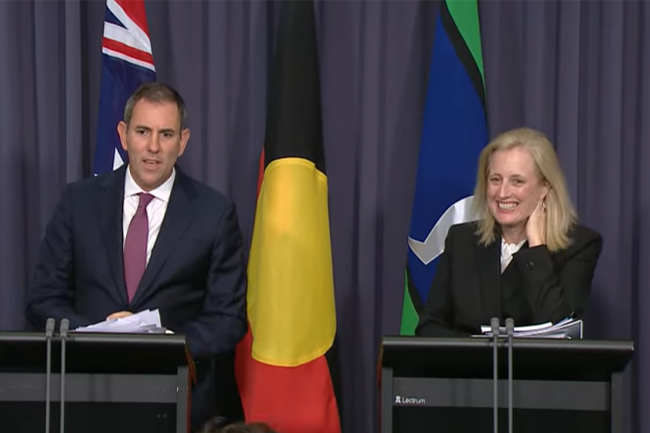Jim Chalmers has cracked open the reform vault, now comes the hard part — getting Australians to buy what’s inside, writes Stephen Koukoulas.
TREASURER Jim Chalmers has opened the debate on what sorts of reforms are needed to keep the Australian economy strong and prosperous.
His Press Club speech was a masterclass in setting the scene for what will be an exciting time for economic policy in the months and years ahead.
Done well, Chalmers can set in train a strategy that permanently boosts the rate of economic growth, supports the growth in real wages and returns the budget to structural balance.
For the bulk of the past decade, economic reform has been piecemeal and lame. This is why Australia’s productivity growth has been poor, why the structural budget balance remains in deficit for the next decade and beyond, and why it has been difficult to see sustained increases in real wages.
Chalmers has said that when it comes to policy changes, in broad terms, everything is open for discussion, even if it is not in the DNA of the Labor Party.
Where might we end up?
In many ways, policies to improve the economic foundations of Australia are well known. A simpler and fairer tax system. A paring back of regulations and so-called “red tape” that are seen to be inhibiting economic activity. Advancing the skills, education and training of the Australian workforce to ensure workers maximise their income-earning potential is good for the economy as well.
There is also a range of other issues, including workforce participation, reducing the duplication of federal-state-local government services, energy efficiency, transport infrastructure and addressing income inequality as issues that impact productivity.
A chronic lack of business investment has been part of the productivity problem. If firms are not investing in technology, machinery and artificial intelligence at a sufficient scale, the productivity of the nation will be constrained.
One of the reasons for the lack of meaningful economic reform over recent decades is politics.
Many reforms mean taking away largesse from some parts of society and these tend to be vocal when their handouts are abolished or scaled back. Witness the current debate on the reforms to superannuants with savings of more than $3 million, or the debate in 2019 about the tax treatment of franking credits and negative gearing.
Indeed, many of the reforms that will be on the Government’s agenda but will be implemented need to be frank with the electorate. The misguided “we will only implement policy where no one is worse off”, which got its legs under the Howard Government, needs to be jettisoned because some people will be worse off if the fiscal impact of those reforms improves the net budget position, one of the key planks of the Chalmers reform criteria.
As the policy agenda gets established, including after the productivity roundtable in August, it is already clear that to make the Australian economy more efficient and productive in both the near term and the long run, tax policy changes will see some inbuilt and costly distortions, to the Government’s budget bottom line, removed.
State and local governments are likely to have some powers removed, as red tape and duplications are addressed. History shows that it is difficult to get consensus and agreement from the eight state and territory administrations to give up some functions, even when it is in the national interest for them to do so.
One difficulty for Jim Chalmers
As the economic reform agenda is discussed and rolled out, the changes will need to be “sold” to the electorate.
In other words, Chalmers and his team will need a major media offensive to address the concerns of the electorate and, more importantly, to outline the benefits to society of the reforms.
Modelling will be needed
Chalmers may want to get the Treasury Department to ramp up its economic modelling unit, so that the benefits to economic growth, jobs, incomes and the budget bottom line can be articulated to what is likely to be a nervous electorate.
Showing that a change in a particular reform adds to GDP and creates a particular number of jobs will make the reforms easier to sell.
It is possible to think of a reform agenda that, when fully implemented, will add 0.25 percentage points to Australia’s annual GDP growth potential, which in turn boosts real wages by 0.5 percentage points per annum and ensures the economy continues to function at full employment.
It will be a tough challenge for Treasurer Chalmers to not only identify the essential reforms but also to implement them. This is particularly so with a noisy Opposition set to disrupt the process.
Stephen Koukoulas is one of Australia’s most respected economists, a past chief economist of Citibank and senior economic advisor to an Australian Prime Minister. You can follow Stephen on Twitter/X @TheKouk.
 This work is licensed under a Creative Commons Attribution-NonCommercial-NoDerivs 3.0 Australia License
This work is licensed under a Creative Commons Attribution-NonCommercial-NoDerivs 3.0 Australia License
Support independent journalism Subscribe to IA.

Related Articles
- Why Chalmers won't be baited by media misreporting the economy
- Treasurer avoids hard reforms on regional bank closures
- Business is booming — defying newsroom doom and gloom
- Chalmers on track to join Keating and Swan as world’s best treasurer
- Jim Chalmers gets the boffins to measure what really matters













